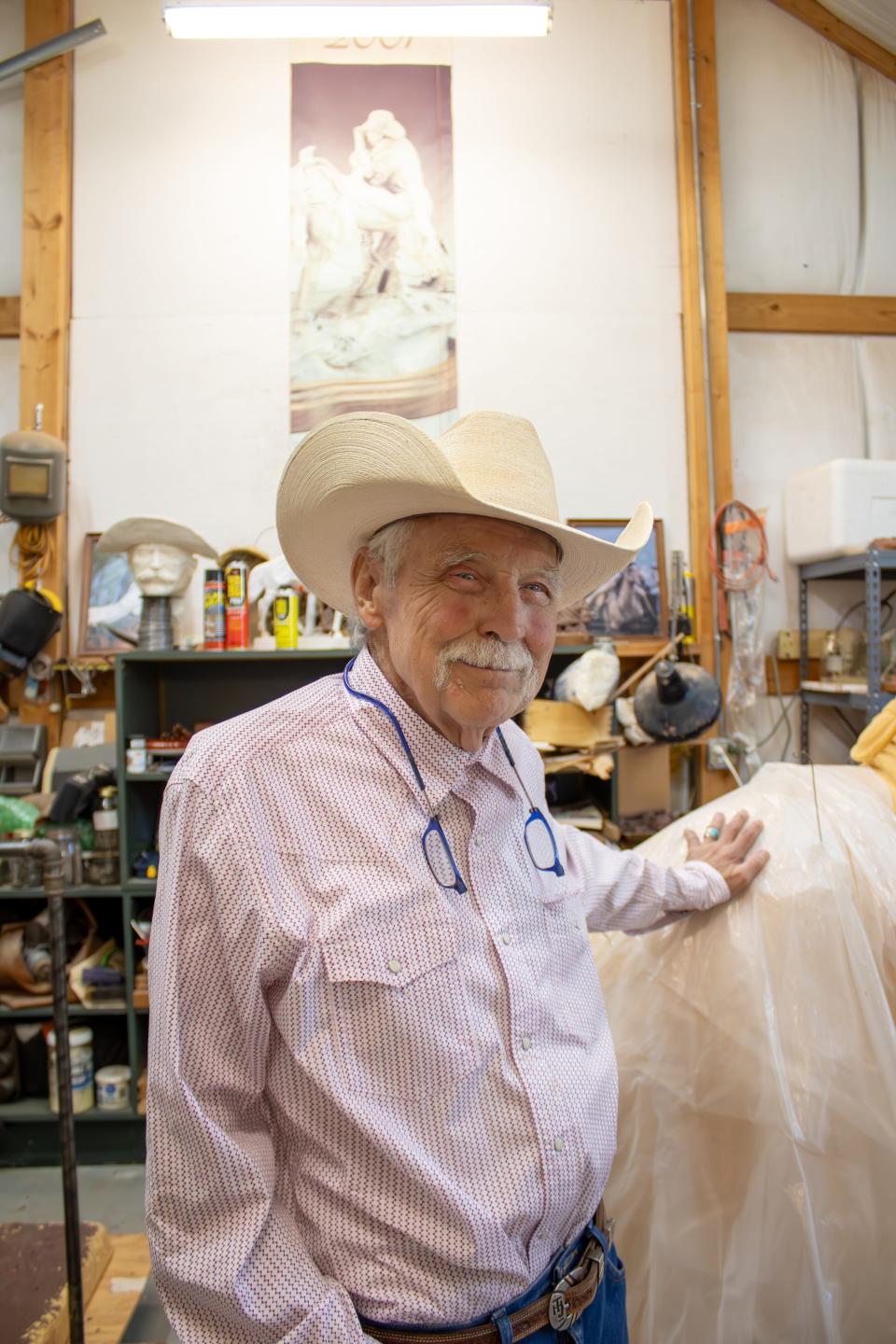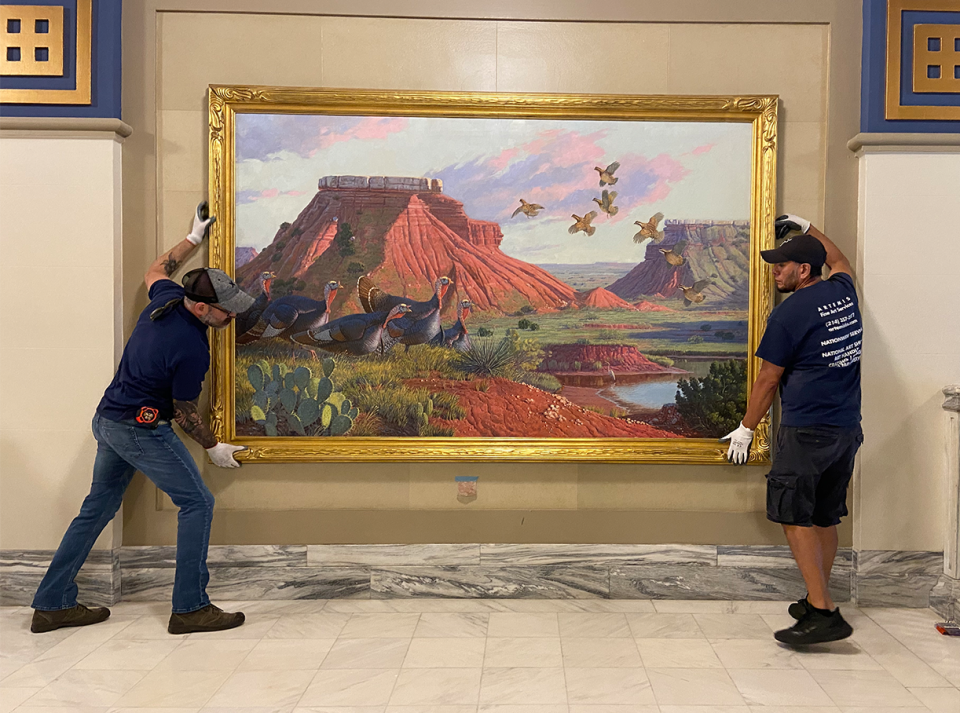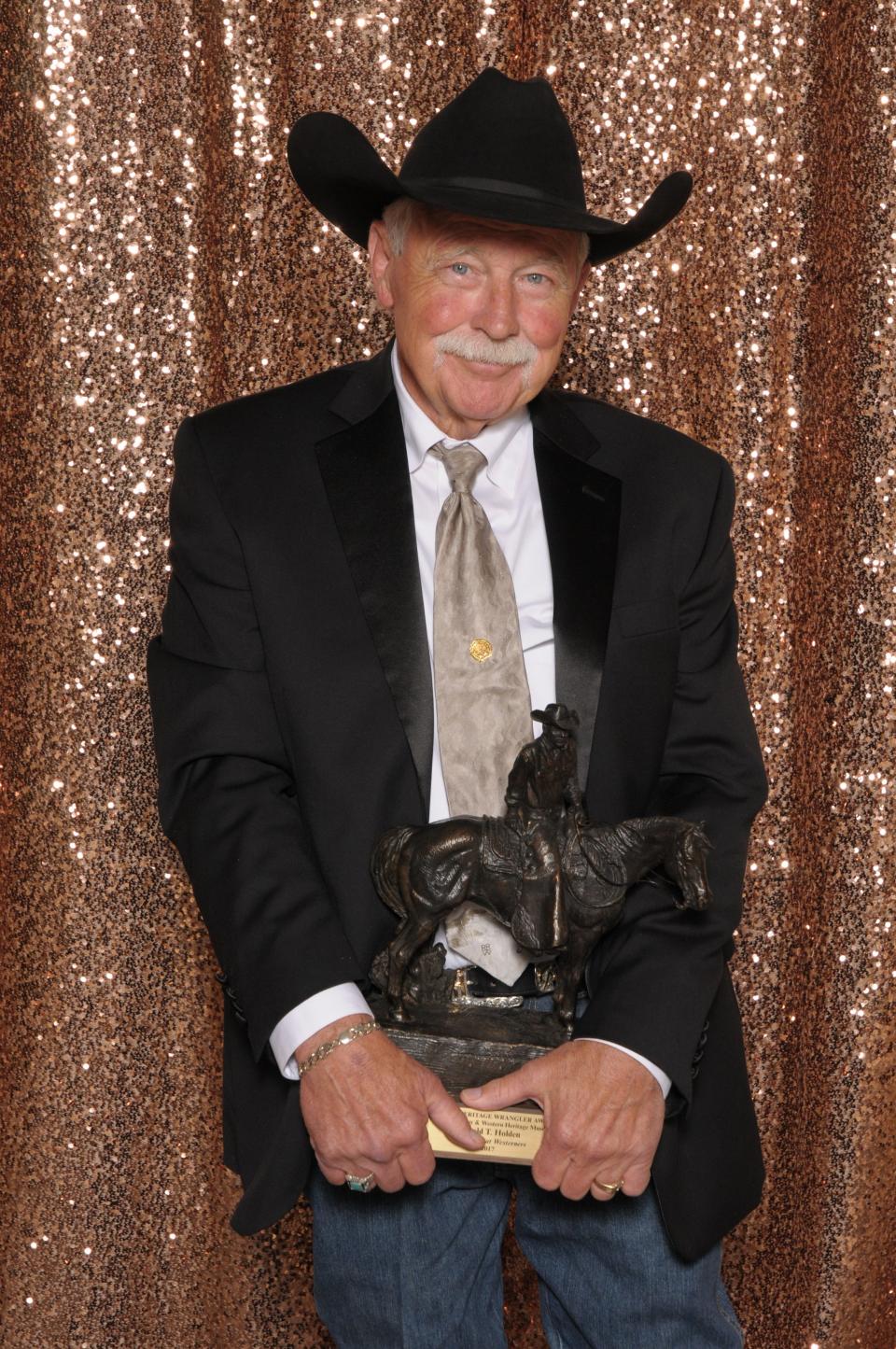'Rest easy, Cowboy.' Oklahoma artist Harold T. Holden, creator of Western monuments at OSU and beyond, dies
From his artwork to his alma mater and even through a near-death experience, Oklahoma artist Harold T. Holden followed the cowboy way.
"As a person and as an artist, Harold embodied many of the qualities associated with the West, and this badge endeared him to his home state," Oklahoma Arts Council Executive Director Amber Sharples said in an email to The Oklahoman.
"Harold’s art exudes a deep, authentic knowledge of Western life, which is characteristic of someone who lived the cowboy code."
A celebrated sculptor and painter whose career spanned 50 years, Holden died Wednesday. He was 83.
Oklahoma artist created larger-than-life Western monuments
Based in Kremlin, Holden built a reputation for sculpting larger-than-life Western monuments like "Oklahoma's Native Son" at Oklahoma City's Will Rogers World Airport, "World Champion" at the OKC Fairgrounds and "We Will Remember" at his alma mater, Oklahoma State University in Stillwater.
"The kneeling cowboy in Gallagher-Iba Arena will forever honor those lost in the January 2001 plane crash that claimed 10 members of the Cowboy basketball team," OSU President Kayse Shrum said in a statement.
"His vision and talent are also reflected in the Boone Pickens and Barry Sanders statues outside the stadium. His artistic style, true Cowboy heart and his life will not be forgotten. Rest easy, Cowboy."
Sculptor came from a long line of inventors and creatives
Holden was born March 28, 1940, in Enid to Patrick Miles and Betty Jane Failing Holden. Although he was the first in his family to pursue a career in the fine arts, he came from a creative line: In 1915, his great-grandfather George Failing invented a bottle-capping machine that is still used today, and his grandfather, oil pioneer George E. Failing, devised the first portable drilling rig, along with numerous drill bits that continued to be used in the industry.
After graduating from Enid High School in 1958, Holden attended OSU. In 1959, a detour to Houston to work on an oil rig led to a chance meeting with an instructor from the Texas Academy of Art, where he earned his degree.
After a stint in the Navy aboard the USS Rainier during the Vietnam War, Holden embarked on a commercial art career, eventually becoming art director at Horseman Magazine.

Love of 'the cowboy way' shaped artist's acclaimed career
Outside his day job, Holden followed his personal passion for painting and sculpting Western subjects, quitting his magazine gig in 1973 to pursue a full-time fine-art career.
"What sparked me to become a Western artist was the subject matter, the lifestyle, the cowboy way,” Holden told The Oklahoman in a 2017 interview. “I knew everything about being a cowboy. I love all of it.”
In 1987, Holden was chosen to sculpt a series of bronzes to depict the 165-year history of the Cherokee Strip in Oklahoma and Kansas, and he completed the first monument of his career, “Boomer,” for the city of Enid. His "Boomer," a sculpture of a rider astride a racing horse, in 1993 was used on a U.S. postage stamp commemorating the centennial of the Cherokee Strip Land Run.
Over the decades, the artist completed 23 more monuments that have been placed across Oklahoma, Texas, Kansas and Arkansas. Some of the most prominent include the bison sculpture "Monarch at Rest" at the Oklahoma History Center; his bronze depiction of "U.S. Deputy Marshal Bass Reeves" in Fort Smith, Arkansas; and his horseman and steer statue "Headin' to Market" in OKC's Stockyards City.
A member of the National Sculpture Society and Cowboy Artists of America, he also completed several monuments for universities and helped build their endowments through the sale of maquettes, or preliminary models, including "The Ranger" for Northwestern Oklahoma State University in Enid, Alva and Woodward; "Broncho" for the University of Central Oklahoma in Edmond; and "Bison Spirit" for Oklahoma Baptist University in Shawnee.
For the National Cowboy & Western Heritage Museum, Holden created the bronze "Wrangler," which is the prize for the winners of the OKC's museum's annual Western Heritage Awards, as well as a 7-foot memorial bronze depicting the late The Oklahoman editor and publisher E.L. Gaylord.
A longtime participant in the museum's prestigious Prix de West Invitational Art Exhibition & Sale, Holden won the coveted James Earle Fraser Sculpture Award in 2020 for his rearing horse and rider "Strike Lightning."
“We’re deeply saddened by the passing of our friend Harold Holden, or as we all affectionately called him, H,” National Cowboy Museum President and CEO Pat Fitzgerald said in a statement.
“As a rancher and horseman, H lived the life he so beautifully captured in his work. ... Our museum, our state and the Western community have lost a true cowboy."
Although he is best known for his sculptures, Holden also was a skilled painter whose vast 2003 landscape "Game Birds at Glass Mountain" is displayed in the state Capitol.
Sculptor survived lung transplant to continue creating for 13 years
Among his works, Holden's monument "Thank You Lord," a 6-foot praying figure that stands in the garden at Enid's Emmanuel Church with a second casting outside the emergency room of OKC's Nazih Zuhdi Transplant Center, had special significance.
In 2007, Holden was diagnosed with the terminal lung disease idiopathic pulmonary fibrosis, and with his health deteriorating, he closed his art studio two years later.
"It was a difficult time, particularly for an independent and self-sufficient man, to become dependent for every need. H prepared himself for what appeared to be the inevitable," Holden's wife, Edna Mae Holden, wrote in a 2021 column in The Oklahoman.

In 2010, the artist received a lung transplant that saved his life and allowed him to keep creating for 13 more years.
At the time of his death, Holden was working on his 25th monument: A statue of one of his boyhood heroes, legendary cowboy Frank Eaton, the inspiration for OSU’s Pistol Pete mascot. A university spokesman said the OSU Foundation plans to work with the Holden family and donors to explore options for the artist's final sculpture.
Artist to be posthumously inducted into hall of fame
As previously announced, Holden also will be inducted into the OSU Alumni Association’s Hall of Fame next February. He received OSU’s Distinguished Alumni Award in 2005.
The posthumous induction will add to the artist’s long list of accolades: He was hailed with the Oklahoma Sculpture Society's lifetime achievement award in 2000, received an Oklahoma Governors Arts Award in 2001 and was added to the Oklahoma Hall of Fame in 2014.

In 2017, Holden became the first Oklahoma artist inducted into the National Cowboy Museum's storied Hall of Great Westerners.
Holden is survived by his wife, Edna Mae, of the home; son, Tim Holden, and wife Allison, of Clifton, Virginia; daughter, Shannon Meyer, and husband Marty, of Enid; sisters, Katy Rieger, and husband Warren, of Tulsa, and Myrlane Mendenhall, and husband Ken, of Edmond; brother-in-law, Bill Simmons, of Granbury, Texas; and grandchildren, Payton Meyer, Morgan Meyer, Silas Holden and Benji Holden.
A celebration of life is set for 2 p.m. Tuesday, Dec. 12 at Emmanuel Enid Church. A private burial in Memorial Park Cemetery will precede the service.
In lieu of flowers, donations can be made to the National Cowboy Museum, Oklahoma Hall of Fame or OSU Foundation with Enid's Ladusau-Evans Funeral Home serving as custodian of the funds.
The dual exhibit "Cowboys and Indians," featuring works by Holden and fellow hall of famer Mike Larsen, a Chickasaw artist based in Perkins, will open Jan. 5 at JRB Art at the Elms art gallery in OKC's Paseo Arts District.
This article originally appeared on Oklahoman: Oklahoman Harold T. Holden, who created larger-than-life artworks, dies
